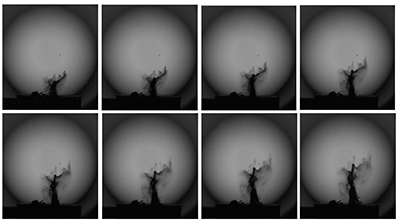High-speed imaging is a core diagnostic capability for NNSS. Experiments that provide essential data for our stockpile mission generally involve measurements on the behavior of materials under extreme conditions. Materials that are shocked and compressed under high-explosive drive as in subcritical experiments, for example, exhibit behavior that changes over very rapid timescales measured in millionths or even billionths of a second that require radiographic or optical imaging to track their motion. Devices called framing cameras provide discrete images over a short period of time, much in the manner of a high-speed movie camera, but with individual shutter times that must be extremely short in order to capture images of rapidly-evolving phenomena such as shock-driven ejecta, dynamic compression of metals, high-velocity fluid flow and others. Such timescales can be as short as nanoseconds (billionths of a second).
The Kraken framing camera, developed as a result of a 5-year investment by the Stockpile Stewardship Program, can capture up to eight high-resolution images (“frames”) over a time sequence that can be set by the user and with individual shutter times as short as 50 nanoseconds. This flexibility, combined with the high resolution of Kraken, make it ideal for applications in stockpile stewardship at U1a and at other venues in the Nuclear Security Enterprise where tracking material motion on short timescales is critical.
Kraken was first fielded in October 2020 in an exploding wire experiment, where it captured the motion of ejecta produced by a laser-driven shock. The resulting ejecta particles were projected into the camera’s field of view and recorded sequentially in eight frames, each with a one microsecond frame exposure and 45-microsecond frame spacing.
The development effort toward a new imager at NNSS that resulted in the Kraken camera enabled increased production rates and reduced costs relative to other fast-imaging technology initiatives around the nation and the world. Kraken’s 8-frame, low-noise, 800 by 800-pixel imaging system represents the first large-area, time-gated imager design by the NNSS. In collaboration with staff at Sandia National Laboratories’ Mesa facility, we leveraged existing designs to enable the fabrication of the imaging sensors with much higher yield and lower per-unit cost. In addition, we deployed a new Universal Camera Architecture for communications which drove shorter lifecycle times in realizing complete, field-ready cameras. So far, three Kraken cameras are complete, and more are in fabrication. Fiscal year 2022 will see several experiments fielded with Kraken cameras.

